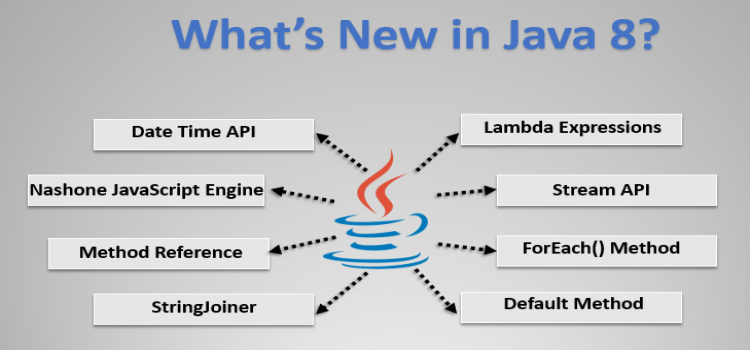What are the new features of Java 8

Java 8 is full of exciting features for both JVM and language level functionalities. While some of the features which were originally mapped out for Java 8 were pushed/released in Java 9, Java 8 still has many features that make it better than Java 7. Most of the updates or features are basically under-the-hood improvements at the compiler, JVM or help-system level.
The above features are in-built and developers don’t have to do anything actively besides installing Java 8 obviously! Now, having cleared this, let us have a look at the java 8 features that you must know about:
Java 8 new features
- Support for Lambda Expressions
- Parallel operations
- forEach() method in Iterable interface
- Java and JavaScript
- New date / time APIs
- Concurrency API improvements etc
1. Support for Lambda Expressions
Not speaking too much generally here, but, the most dominant feature in favor of the Java developers is the support provided for Lambda expressions. Java’s lambda expressions are a crucial element as compared to the approach taken by scala.
Aspiring Java developers should be at least familiar with the Lambda syntax, how it relates to array and collection operations and where they are integrated with the core language libraries.
2. Parallel operations
In addition to Lambda expressions, java designed a concept of internal iterations. Generally speaking, the most commonly used programming idioms are loop operations like if, else, etc. Lambda expressions turned this trend around with internal iterations.
This opened up a lot of possibilities like enabling operations such as sorting, filtering, and mapping in long arrays to be carried out parallel outside the framework. This is very helpful in situations with lengthy code processing collection on the server-side to increase throughput while reducing effort by the developer.
3. Java and JavaScript
Java 8 has released a completely new JVM based Javascript engine, Nashborn. Its release is to minimize the gap between Java and Javascript. The Nashborn engine uses features like invoke dynamic to facilitate JVM level execution speeds.
This also means that if you want to introduce JS in your backend, there is no need for node.js. Developers can simply use the JVM to execute the JS code. Here, the added bonus is also the ability to maintain seamless interoperability among the different codebases without having to use IPC/RPC for bridging the gaps.
4. New date / time APIs
Complexity and difficulty of using the Java Library API have been the main problem for many developers. In Java 8, Joda has been adopted with its own customizations of new date/time API from scratch. Now, unlike Calendar.getInstance(), the new APIs designed are focused on simplicity, clarity of operations especially in manipulated values both in human and machine-readable time formats.
Wrapping Up
The Java 8 new features are innovative, clear and focus on greater efficiency and throughput while reducing the effort to achieve goals. Though it may have its own shortcomings and disadvantages, that’s why they release updates. If you are applying for a position as a Java Developer, have a read of the Java Questions here.
